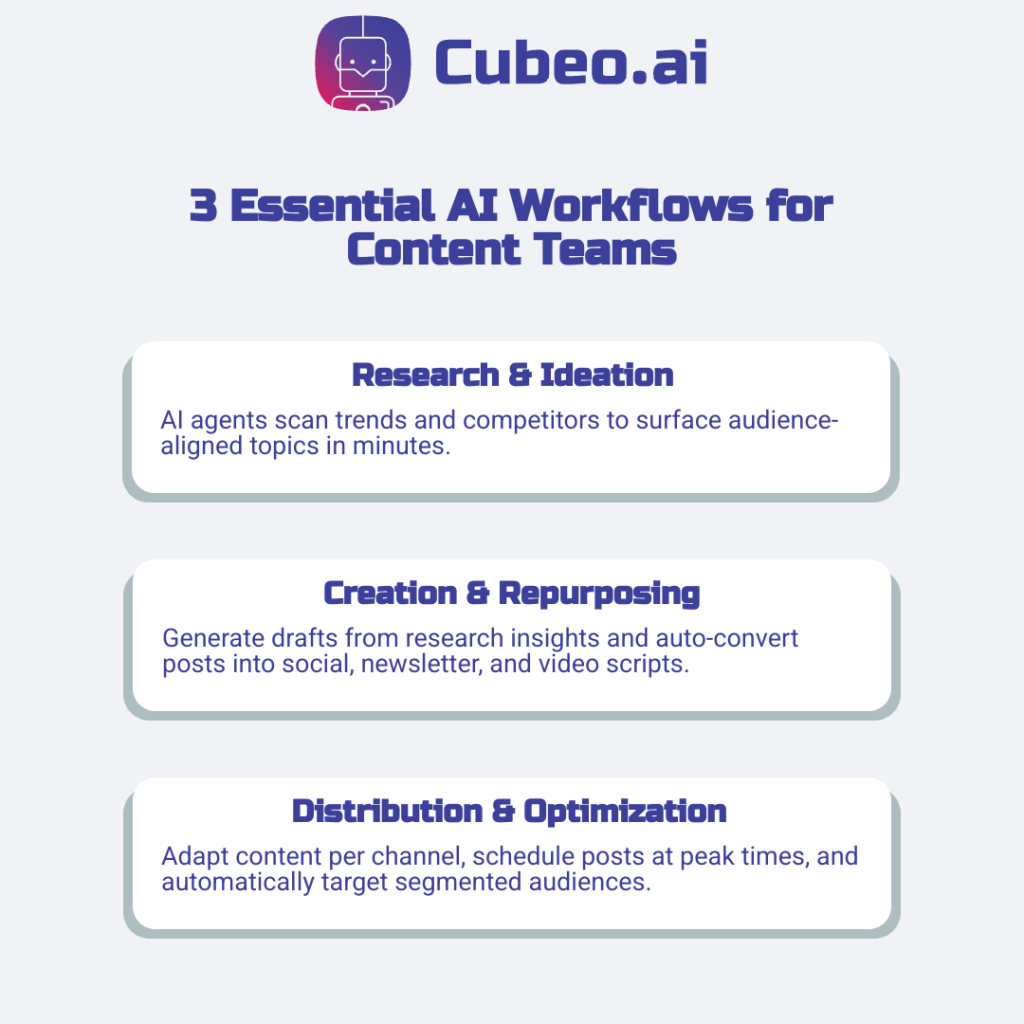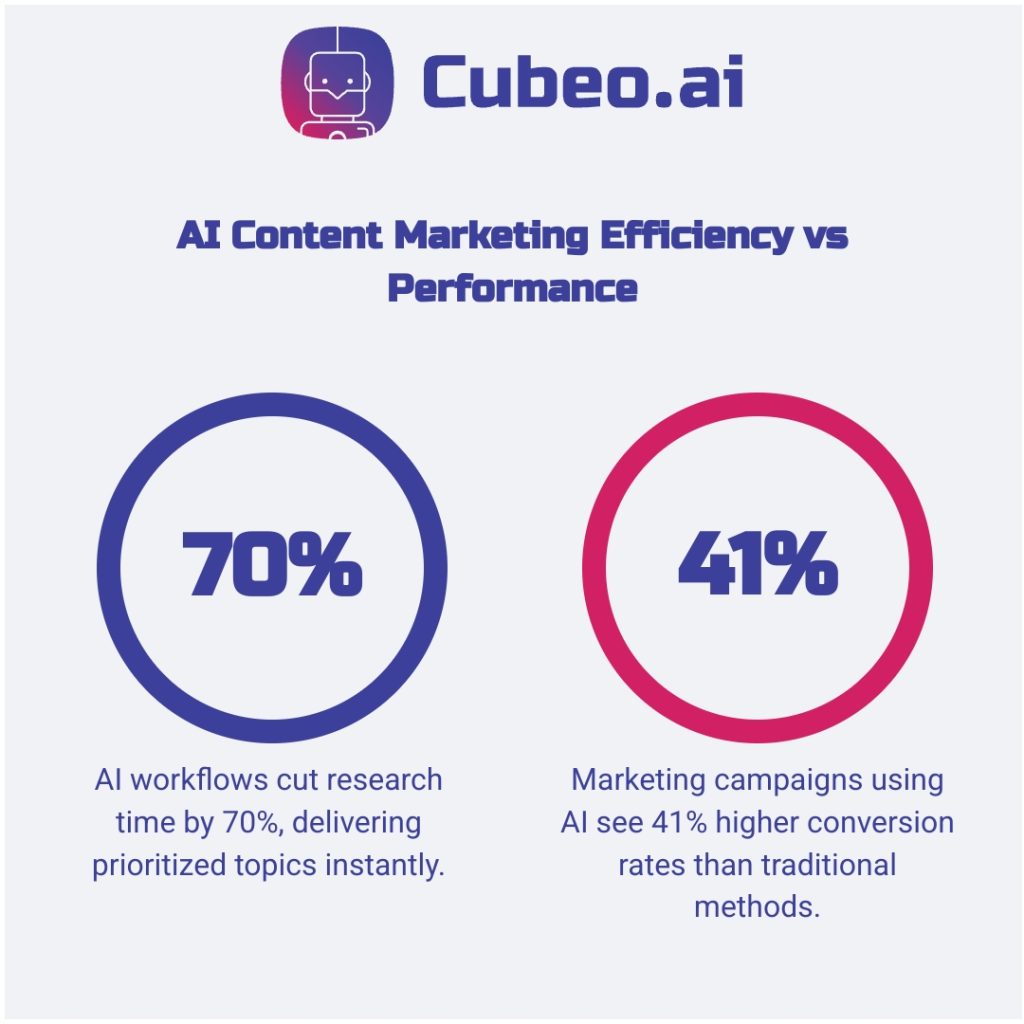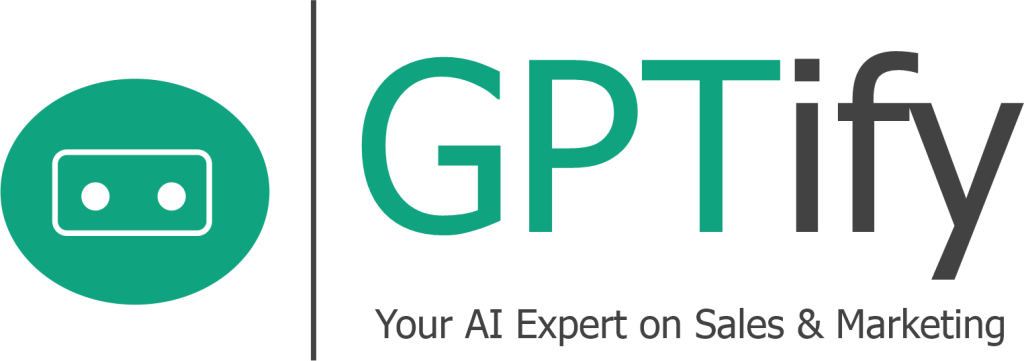Picture this: your content team must publish more, rank higher, and convert better, without hiring engineers.
Think of an LLM as a knowledge engine and retrieval-grounding as its GPS: the engine needs a local map to stay accurate. Multi-agent workflows let each AI handle specific tasks (research, writing, fact-checking, optimization) while maintaining quality standards.
This guide shows how to build these no-code pipelines that deliver measurable KPIs. We’ll cover high-impact AI in content marketing use cases you can pilot immediately and performance metrics that justify investment.
AI-driven teams are transforming content operations from reactive tasks to predictable growth engines.
AI Use Cases Every Content Team Should Know
Use AI to cut idea discovery time and automatically generate platform-ready snippets so your team publishes more with the same headcount.
Content teams manage an overwhelming mix of research, writing, editing, and distribution tasks. AI transforms this chaos into organized workflows where each tool handles specific responsibilities. Modern teams use multiple AI tools together to connect research, creation, and distribution into seamless systems that mirror how your team already works.
How AI Handles Research and Ideation
AI does the detective work that used to take hours. Agents scan trending keywords, competitor posts, and search patterns to surface ideas that map to your audience.
Competitive research automation summarizes competitor formats and highlights angles that work. Instead of checking dozens of sites, you receive a prioritized list of topics to test.
Gap analysis compares your archive to search demand and competitor coverage, flagging pages to refresh or topics to create. This comprehensive approach to AI marketing applications ensures your content strategy stays data-driven.
Content Creation and Repurposing Workflows
Draft generation gives you a usable first draft based on research insights, brand guidelines, and audience signals. The agent builds structure and core copy so you spend time on expertise and nuance, not blank pages.
Multi-format adaptation converts one post into social snippets, newsletter sections, and video script outlines automatically. A single blog post becomes content for multiple channels without manual reformatting.
Brand voice consistency gets maintained through training on your existing content. The system learns your tone, terminology, and style preferences, ensuring all generated content matches your established voice. These AI content marketing workflows help teams scale without losing their unique personality.
Distribution and Audience Optimization
Channel-specific optimization means agents adapt your content for each platform’s requirements automatically. LinkedIn posts get professional formatting, Twitter content stays within character limits, and Instagram captions include relevant hashtags.
Timing and frequency automation uses audience behavior data to schedule content when your specific audience is most active. Systems analyze engagement patterns and adjust posting schedules to maximize reach and interaction.
Audience segmentation works by analyzing user behavior, interests, and engagement history to create targeted content variations. Different audience segments receive content tailored to their specific needs and preferences, improving relevance without manual customization work.

AI Content Marketing Stats, KPIs and ROI
The numbers are clear: teams using AI in content marketing capture measurable gains. ColorWhistle (2025) reports a 20% average lift in marketing ROI, and SQ Magazine (2025) finds content programs deliver $7.65 per $1 spent.
Current Adoption and Market Trends
Market adoption is accelerating rapidly. According to recent surveys, professional marketers are integrating AI tools across their content workflows at unprecedented rates.
ColorWhistle (2025), citing Gartner, reports a projected 37% growth in organizations using AI for marketing functions between 2023-2025. Meanwhile, 81% of marketers consider content marketing a core business strategy (SQ Magazine, 2025), with AI becoming the primary scaling mechanism.
Time and Cost Savings Benchmarks
Production efficiency gains are substantial and measurable. AI content workflows reduce research time by 70% and first-draft generation time by 45% (ColorWhistle, 2025 — synthesis of industry benchmarks).
Global usage statistics confirm these patterns, with teams reporting significant cost efficiencies when AI handles research, initial drafting, and format adaptation tasks that previously required manual effort.
Quality and Performance Impact
AI also delivers measurable business outcomes. Marketing campaigns using AI for content optimization experience 41% higher conversion rates (ColorWhistle, 2025 — citing McKinsey data) compared to traditional approaches.
Content optimized with AI shows 83% higher engagement rates (ColorWhistle, 2025), while AI-powered personalization leads to 40% increases in average order value. These metrics reflect AI’s ability to match content precisely to audience intent and behavior patterns.

How to use Cubeo AI for content marketing
Cubeo AI lets you build no-code agents that handle the heavy lifting across your content pipeline. Start with one agent, or connect several into a multi-agent workflow.
- AI Blog Writer & Researcher — Generates SEO-ready drafts, expands main keywords with long-tails, and follows your brand voice.
- Keyword & Topic Cluster Finder — Surfaces search intent, clusters topics, and identifies competitor gaps you can target next.
- AI Content Repurposing Agent — Turns one article into LinkedIn posts, newsletter snippets, and short scripts, formatted per channel.
- AI Social Media Strategist — Proposes post ideas, hooks, and posting cadences aligned to your audience and goals.
- SEO Optimizer & Link Builder — Ensures structure and optimal word count and inserts internal and external links automatically.
- External Links Finder Agent — Finds credible outbound sources to strengthen E-E-A-T and support claims.
FAQ
What's the ROI timeline for implementing AI in content marketing?
Implementing AI in content marketing can yield a return on investment (ROI) that spans both quantitative and qualitative outcomes, with some reports indicating potential increases of 15- 20% or even 20-30% higher ROI on campaigns compared to traditional methods. Unlike traditional tactics, AI impacts multiple parts of the campaign lifecycle, from creative production to targeting and real-time optimization, meaning ROI needs to capture efficiency, agility, and accuracy, not just immediate revenue.
On the quantitative side, marketers track improvements in revenue, cost-per-acquisition, and lifetime value. Qualitatively, AI can boost brand reputation, customer satisfaction, and trust through personalization and data-driven decision-making. To get a complete picture, it’s essential to combine these metrics into a single ROI assessment, considering revenue gains, cost savings, retention benefits, and operational efficiencies against total AI costs. Businesses should measure key performance indicators (KPIs) like engagement rates, click-through rates (CTR), conversion rates, and customer retention rates to understand the full impact of AI driven content.
How do you maintain brand voice consistency with AI content creation?
Maintaining brand voice consistency with AI content creation is a continuous process that requires careful planning and strategic integration of AI tools. AI-powered content creation tools can analyze existing content to understand and replicate a brand’s unique voice, ensuring consistency across all communications, especially when scaling content creation efforts.
To achieve this, it’s crucial to clearly define your brand voice by creating comprehensive brand guidelines that outline your brand’s tone, style, and language preferences. This includes identifying whether your brand voice is formal, conversational, humorous, or authoritative, and inputting brand-specific terms into the AI tools to keep the content aligned with your unique messaging. By feeding the AI tool your brand voice guidelines, do’s and don’ts, and successful content examples, you enable it to generate content that aligns with your brand’s voice across the enterprise.
While AI offers immense potential for streamlining content creation, it’s important to balance automation with human creativity. Avoid relying solely on AI tools for all content creation, especially for storytelling. Instead, use AI for routine content generation and as a foundation for bigger creative strategies, reserving creative campaigns for human input. This hybrid approach, combining human insight with AI capabilities, ensures that the content remains authentic, engaging, and consistent with your brand’s unique identity across all communication channels.
What are the most common implementation challenges with AI content workflows?
Implementing AI content marketing tools and workflows often presents several challenges, primarily stemming from approaching AI as a purely technological solution rather than a comprehensive transformation. One of the biggest hurdles is misaligned expectations about AI capabilities, where companies may rush implementation without proper planning or staff training, leading to underutilized tools and a lack of measurable returns.
Key challenges include data quality and fragmentation, as AI agents cannot perform effectively in environments with disconnected systems and inadequate data. Integrating AI with existing legacy systems can also be complex, requiring significant workflow redesigns and potentially facing resistance from employees comfortable with the status quo. This mismatch between idealized, linear workflows and the reality of human judgment and informal coordination can create friction and slow adoption.
To overcome these challenges, businesses must define clear objectives, build the right teams, and prioritize effective change management. This involves making clear and early communication to all stakeholders about the purpose and benefits of AI, engaging employees in planning and implementation to promote ownership, and offering training and resources for new workflows. Framing AI as an aid to, rather than a substitute for, human abilities, and focusing on delivering secure, reliable solutions that work in almost every environment, not just test environments, are crucial for successful adoption and unlocking real ROI.
How do you measure the quality of AI-generated content versus human created content?
Measuring the quality of AI-generated content versus human-created content involves a multi-faceted approach, as each has distinct strengths and weaknesses. While AI tools are rapidly developing, their content generation capabilities are often constrained by existing data, which can lead to inconsistencies and a lack of fresh, distinctive outputs compared to human-written content. Humans, on the other hand, excel in innovation, originality, and the ability to grasp the creative process, effortlessly connecting disparate ideas and adapting to shifting circumstances.
To systematically evaluate AI-generated content, key criteria include factual accuracy, coherence, ethical safety, and human-likeness. A balanced approach often involves hybrid evaluation, combining human insight with automated scoring. AI can handle large-scale, surface-level assessments, while humans verify content requiring nuanced understanding, emotional intelligence, or ethical considerations. This method increases reliability without sacrificing efficiency. Ultimately, while AI can be a helpful editor for spelling, grammar, and cohesiveness in first drafts, human oversight remains critical for ensuring content resonates with audiences, maintains brand authenticity, and addresses the complexities that machines cannot independently grasp.



